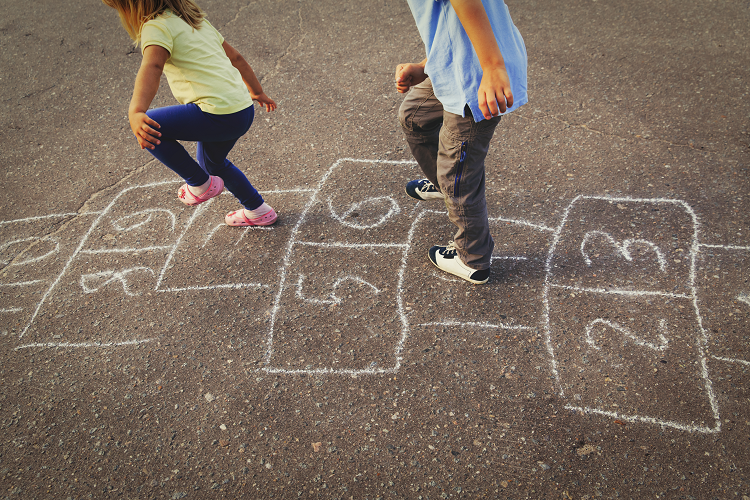
What Works to Get Kids More Active?
We all almost presume that our kids are active enough. But did you know they need at least one hour of moderate to vigorous activity each day? This should include aerobic activity as well as age-appropriate muscle and bone-strengthening activities like push-ups, rope-jumping and running.
The good news is that it doesn’t have to be all in one go: ten minutes here and 20 minutes there is just as effective for maintaining health as opposed to doing it all in one time slot.
Are Mine Getting Enough?
Have a think about your own week, and your children’s. Add it up in your head. I’m very health conscious – it’s my job – and yet I know that, during the winter months, mine sometimes don’t get enough.
Obviously the summer is always more active, but I’m aware that the one hour quota is too important to just squeeze into one part of the year; it has to be more consistent.
Thankfully they do naturally incline towards sports, plus they enjoy active games at break time (like skipping and chasing), but I’m also aware that, as children turn into teens, this can fall away.
For instance, I’m terrified by the statistic showing that half of girls drop out of sport before the age of 14. Half! These figures aren’t reflected as dramatically with boys. I’ll be doing everything I can to keep my two girls active at that age, particularly as I know how important it is for mental health and confidence, but who knows how challenging that will be?
It’s important to get them involved in activities they love now, so that it hopefully sticks. As parents, all we want is for them to be healthy and happy so below are some ideas of how to get things moving.
10 Ways To Get Kids More Active
1. Get outside: It’s tempting to stay snuggled indoors all winter long, but the reality is that we have a long winter and if we just gave into it, nobody would exercise. Wrap up in layers and remind your children that they’ll warm up after just 5-10 minutes. A hike – packed with healthy picnic – is great for all the family. Pick a local hill or mountain, or go further afield or a bit of adventure: for Dublin readers, try Outsider.ie or for nationwide try this great article on Independent.ie.
For those looking for something more leisurely, an after-lunch or after-dinner walk around your neighbourhood, if done briskly, is enough to get everyone’s heart rate up. Then light a fire when you get home and you’ll all feel the glowing endorphins!
2. Set up a fun ‘circuit’: If the rain prevents an outdoor excursion, get a timer and encourage your kids to make a ‘circuit challenge’ in the house. Have a sit-up station, a push-ups station and a jumping jack station (you could also add small weights for older teens) – make sure that you join it with them and spend two minutes at each station, with music pumping in the background for added fun!
If you have a child who doesn’t naturally enjoy this kind of thing, add in a board-game station or an art station to distract. For smaller kids, make an ‘obstacle course’ or jumping area with pillows and cushions.
3. Encourage them to ‘buddy-up’: Join them or organise a friend to partake in a dog walk, a visit to the park with a ball or a bounce on the trampoline. Alternatively, try to carve out some time for an outing that incorporates physical activity with a pal, or group of pals, such as indoor ice- skating, swimming or an indoor climbing wall.
A trip to the local indoor trampoline centre can suffice if it’s pouring rain outdoors, but also even a trip to the shops can work too – march them from shop to shop and they’ll soon be complaining of tired legs!
4. Enroll them in a class or on a team: Don’t give up trying! It took us trying dancing, hockey, rugby and tennis before we hit on GAA for our daughter – and now she loves it. She never complains about training twice per week and enjoys the matches.
But one bit of advice – don’t pay to join or buy all the gear before you are you’re child is going to stick at it! Most organisations are good about this and allow you to defer payment until the third week or so.
Also, don’t think that all of your children will like the same thing; it may mean having to go in separate directions but try to tailor the sport to fit the child rather than the other way around.
5. Dance at home: Put on music and just dance around your sitting room or the kitchen while making dinner. Most of us have tried it, but do we do it regularly enough? It’s fun, it’s active and you burn calories too – what’s not to like? Give the kids turn choosing their favourite tune and have a dance-off. Add in glow sticks to make it extra fun and video yourselves so you can play it back and have a laugh later.
6. Play games with them: You can’t beat skipping, hula-hooping or hopscotch for a bit out outdoor fun. Mine also love ‘tip the can’ and it can involve a fair amount of sprinting (the adrenalin pumps as we try to make it to the tree in time!).
Also don’t forget visiting rock-pools or chasing each other on the sand dunes on beaches – you can’t beat it, especially if there’s any warmth in the air. Wherever there is plenty of space – such as forests, parks or the beach – it isn’t just the children who benefit from the sense of freedom. It’s good for the soul.
Open space is all they really need to be active – chasing, climbing and running.
Plus it’s free!
7. Adapt the home for older kids: Consider buying some inexpensive gym equipment (often available in budget supermarkets) and set up a ‘gym’ section of the house. This, combined with a speaker and their favourite tunes, is all that’s required – no need for expensive gym membership.
Or try physical activity apps and get fit together, such as Nike Training Club or Sworkit.
8. Take time to visit your school’s principal: We are lucky to have yoga and cycle-safety as part of our children’s school day (with some year groups also offered swimming) but if you feel that you’d like more activity in your child’s day, it might be worth going in to speak with your school’s principal. They may have something planned that you didn’t know about coming up but do raise the issue with him/her if not.
9. Limit screen time: Children now spend more than 7.5 hours a day in front of a screen. Think about yourself when you were a child and you were bored – chances are you headed outside. Now, sadly, our children don’t get the opportunity to be bored. So it’s become increasingly difficult to channel them into activity. Put rules back in place if they’ve fallen away.
Remember that we’re the ones in charge – being too slack with screens is sometimes down to our own laziness. And don’t forget how crucial it is to role model for them. If you’re bringing them to a park or beach to be active, put the phone away! They need direct eye contact and focus. If you have one eye constantly on your phone, they’ll sense it and it will lessen their own interest in being there.
10. Focus on effort, not outcome: Experts say that where parents often go wrong is when they get to competitive when it comes to their children’s activity. Lots of praise is crucial, particularly for children who aren’t naturally athletic or sporty. But shouting from the sideline doesn’t sometimes help. Some parents volunteer on a team to help support their child, which is a great way to encourage them.
And no matter how uncoordinated or out of shape your child is, they need to hear that they’re doing great, even for reaching a small goal, such as getting their hand on the ball or cycling that bit farther on a given day. If you don’t have time to volunteer, quietly take one of the other volunteers aside and ask them to throw in a few compliments to your child – it may be just the thing to keep them at it.
For more motivation to exercise, read my blog about common exercise excuses and 8 ways that exercise can boost mood and brain power.
To get kids more active – as with all our series on tips for better health and living – set a target of incorporating one of the activities into your weekly routine. Then add another and let that settle in. Before you know it, you’ll be hitting the recommended physical activity levels for your child/children.
Happy moving everyone!



